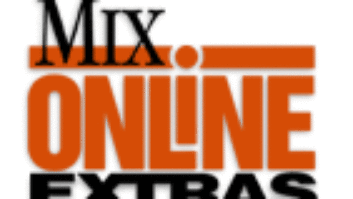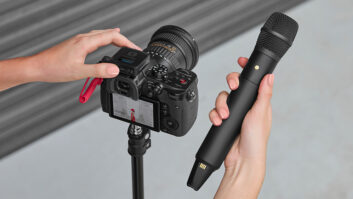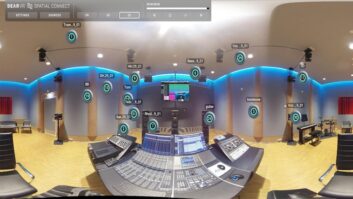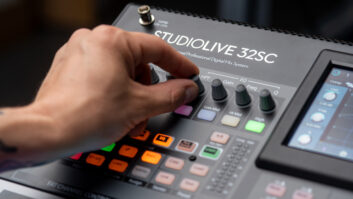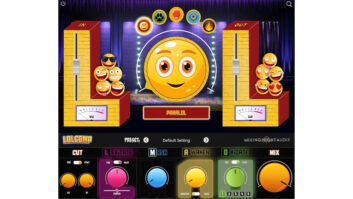Sue Pelino, VP, audio post-production for Creative Group, a full-service post production facility headquartered in New York City, is an accomplished mixer—she’s a winner of two Emmy awards and has more than 15 years’ experience mixing music. Currently, she’s working on the new Sundance Channel Series Spectacle: Elvis Costello With…, which premiered on December 3 and features such artists as James Taylor, Diana Krall and Jacob Dylan.
Describe your work for the Spectacle: Elvis Costello With…
I did the final mix of the show. I didn’t mix all of the episodes. I mixed the second-half of the season.
Tell us about the production workflow
It really started with my friend Jay Vicari at Mix Music Mobile, who recorded the series in his new truck and mixed the songs. He recorded all of the iso tracks, including every iso instrument, and all of the isolated audience tracks, of which I believe there were eight, with all the lav mics and handheld mics, to Pro Tools and then gave me all these elements, along with a copy of all the songs on the show, which he remixed in 5.1. I also received the OMF from the Avid editor, who cut the final picture.
I conformed and synched up all the tracks to the first version [of the mix], which was for the Sundance Channel. I conformed all of the tracks to the new final video cut.
When it came to creating that intimacy for the home audience, it was important to do a really good surround mix and blend in the audience so that it translated exactly to how the audience sounded in the music mixes. I always start my mix in 5.1 and then mix in 5.1 and stereo simultaneously, so I’m continually going back and forth and making sure all the transitions translate perfectly in both stereo and 5.1. Because, of course, when you mix a show in 5.1 and stereo, you might need to go back and do some tweaks here and there to ensure it translates perfectly in stereo, as well.
I basically matched into each show, listened very closely to what Jay did, and matched the audience and overall sound exactly. We wanted it to have a really good surround presence and really feel like you’re in the theater. So for the 5.1 mix, we went back to the original iso of each track and did any necessary cleanup.
What other kinds of sounds did you handle for the mix?
What I worked with incorporated all of the audience tracks, the music remix, the lav mics for each performer and the one for Elvis. There were also the performers’ instruments and [the sounds from] when they were sitting and having an interview. For example, a performer might be playing the guitar, but during the interview just sitting in a chair instead of doing an actual performance. So Jay would not have remixed that section; I would remix that section. I did the part where they were sitting down for the interview.
A show like this is likely to open some improvisation on the part of the host and performers. What kinds of challenges did that present to you as the audio mixer?
The biggest trick with that was making the vocal sound good just using that lav mic. It sometimes gets tricky because it’s not like they’re in the band setup. Mainly, however, it’s just a matter of matching the lavs and cleaning them up a bit. Sometimes you’ll hear some fan noise or some people moving around backstage. But because Spectaclewas recorded so pristinely, that wasn’t much of a problem. We started off with really good recorded tracks. And everything was laid out very well and recorded perfectly.
How did you handle creating different deliverables for not only the Sundance Channel, but also on Channel 4 in the UK and CTV in Canada?
Each are a little different content- and sequence-wise. All of the versions are 5.1 and stereo, and we also had to deliver split-files, split-mix stems, for each of the channels on a DVD-R. Also, for one of the channels, we had to do a Dolby-E encode of the 5.1. They wanted the 5.1 as a Dolby-E as opposed to taking it as discreet 5.1.
Once I did the main show for Sundance, which is what we did first because all the other shows were built from that, I then took all of those elements and incorporated them into the other three versions. I should also mention that Jay Vicari mixed the songs in 5.1 and then I did a 5.1 folddown of the music to create the stereo mix of the songs in Pro Tools. So I did a folddown in Pro Tools. At the same time, I mixed the entire show in both 5.1 and stereo simultaneously. But the only elements that got folded down were the songs, the music mixes. All the networks are getting 5.1 and stereo, as well as HD on an HD-SR HD tape. Once I finished mixing, I did the layback for the HD-SR tapes for each episode and then the networks did their additional deliverables and dubs and digi-down converts, et cetera, from those four masters.
We also had to provide a full mix-minus dialog for this show. So every time the audience laughed or clapped, I had to put in additional laugh or clap. I did this by building from samples from the actual show.
What pieces of gear are you using?
Everything was recorded and mixed in Pro Tools HD. I didn’t use any additional outboard gear. The only other outboard gear we used besides the HD-SR machines to lay back to was the whole Dolby-E gear for that one master. All of our rooms here at Creative Group are equipped with full racks of Dolby gear.

